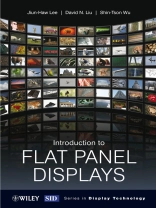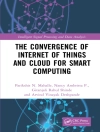Flat Panel Displays (FPDs) are a frequent feature in our daily lives, used in mobile phones, laptop computers, desktop computer monitors and TVs. Several display technologies have been developed for FPDs, such as liquid crystal display (LCD), plasma display panel (PDP), light emitting diode (LED), organic light emitting device (OLED) and field emission display (FED).
Introduction to Flat Panel Displays describes the fundamental sciences behind each display technology: LCD, PDP, LED, OLED and FED including carbon nanotubes. It contains a comparative analysis of the different display technologies in which detailed overviews of each technology are linked together so as to provide a comprehensive reference for students and display engineers, alike. Solved problems as well as homework problems are provided in each chapter to help consolidate students’ reading, as well as solutions hosted on an accompanying website.
Features include:
* the classifications and specifications of display technologies as guidelines for developing a display and judging their performances;
* principles for designing color displays with good color saturation and wide color gamut;
* basic operating principles of thin-film transistors (TFTs) and their applications to state-of-the-art TFT-LCD and TFT-OLED;
* an overview of FED fundamentals comprising the physics of field emission, as well as FED structure and display mechanism.
Senior undergraduate and graduate students taking courses in engineering, physics and chemistry will benefit from the systematic approach used throughout the book, which will help to prepare students for entry into a display profession. Display engineers, research scientists and technicians working on the development of flat panel display technology will also find this book an invaluable resource. Comparisons of the strengths and weaknesses of each of the display technologies will help professionals to decide which to use for their applications.
The Society for Information Display (SID) is an international society, which has the aim of encouraging the development of all aspects of the field of information display. Complementary to the aims of the society, the Wiley-SID series is intended to explain the latest developments in information display technology at a professional level. The broad scope of the series addresses all facets of information displays from technical aspects through systems and prototypes to standards and ergonomics
Jadual kandungan
Series Editor’s Foreword.
About the authors.
Preface.
Acknowledgements.
1. Introduction.
1.1. Flat panel displays.
1.2. Emissive and nonemissive displays.
1.3. Display specifications.
1.4. Applications of flat panel displays.
2. Color science and engineering.
2.1. Introduction.
2.2. The eye.
2.3. Colorimetry.
2.4. Production and reproduction of colors.
3. Thin-film transistors.
3.1. Introduction.
3.2. Basic concepts of crystallized semiconductor materials.
3.3. Disordered semiconductors.
3.4. Thin-film transistor characteristics.
3.5. Passive matrix and active matrix driving schemes.
3.6. Non-silicon-based thin-film transistors.
4. Liquid crystal displays.
4.1. Introduction.
4.2. Transmissive thin-film transistor liquid crystal
displays.
4.3. Liquid crystal materials.
4.4. Liquid crystal alignment.
4.5. Homogeneous cell.
4.6. Twisted nematic.
4.7. In-Plane switching.
4.8. Fringe field switching.
4.9. Vertical alignment.
4.10. Optically compensated bend cell.
4.11. Transflective liquid crystal displays.
4.12. Future directions.
5. Plasma display panels.
5.1. Introduction.
5.2. Physics of gas discharge.
5.3. Plasma display panels.
5.4. Front plate techniques.
5.5. Rear plate techniques.
5.6. Assembly and aging techniques.
5.7. System techniques.
6. Light-emitting diodes.
6.1. Introduction.
6.2. Material systems.
6.3. Diode characteristics.
6.4. Light-emitting characteristics.
6.5. Device fabrication.
6.6. Applications.
7. Organic light-emitting devices.
7.1. Introduction.
7.2. Energy states in organic materials.
7.3. Photophysical processes.
7.4. Carrier injection, transport and recombination.
7.5. Structure, fabrication and characterization.
7.6. Improvement of internal quantum efficiency.
7.7. Improvement of extraction efficiency.
8. Field emission displays.
8.1. Introduction.
8.2. Physics of field emission.
8.3. FED structure and display mechanism.
8.4. Emitter.
8.5. Panel process.
8.6. Field emission array plate techniques.
8.7. Phosphor plate techniques.
8.8. Assembly and aging techniques.
8.9. System techniques.
Index.
Mengenai Pengarang
Jiun-Haw Lee received BSEE, MSEE and Ph D degrees in
electrical engineering in 1994, 1995 and 2000, respectively, all
from National Taiwan University, Taipei, Taiwan. From 2000 to 2003
he was with the Ri Tdisplay Corporation as the director. In 2003 he
joined the faculty of National Taiwan University in the Graduate
Institute of Photonics an Optoelectronics and the Department of
Electrical Engineering, where he is currently an associate
professor. His research interests include organic light-emitting
devices, display technologies and solid-state lighting.
Dr Lee is a member of the IEEE, OSA, MRS and SPIE. He received
the Exploration Research Award of Pan Wen Yuan Foundation and Lam
research Award in both 2005 and 2006. He has published over 40
journal papers, 100 conference papers and 20 issued patents.
David N. Liu has been the director of the Strategic
Planning Division in the Display Technology center (DTC) of the
Industrial Technology research Institute (ITRI) since 2006. He
worked on IC and field emission displays at ERSO (Electronics
Research and Service Organization/ITRI and Bellcore (Bell
Communication research) from 1983 to 1996. He started his research
and development work on plasma display panels at Acer Peripheral
Inc. and and AUO from 1996 to 2002. After his service at AUO, he
was in charge of the flat panel display technology division in
ERSO/ITRI until 2006.
Dr Liu received his Ph D degree in electrical engineering from
New Jersey Institute of Technology in 1992. He has over 45 issued
patents, 18 published papers and a contributed chapter of the
Semiconductor Manufacturing Handbook (Mc Graw-Hill, 2005). He also
successfully developed field emission displays, plasma display
panels and flat panel displays followed by the receipt of many
awards from ITRI, Photonics Industry and technology Development
Association, Administration Bureau of Science base Industry Park
and the Ministry of Economic Affairs (MOEA). He was also a
recipient of the Outstanding Project Leader Award from MOEA in
2006.
Shin-Tson Wu is a PREP professor at the College of Optics
and Photonics, University of central Florida (UCF). Prior to
joining UCF in 2001, Dr Wu worked at Hughes Research Laboratories
(Malibu, California) for 18 years. He received his Ph D in physics
from the University of Southern California (Los Angeles) and BS in
physics from National Taiwan University (Taipei).
Prof. Wu has co-authored four books: Fundamentals of Liquid
Crystal Devices (Wiley, 2006), Introduction to Microdisplays
(Wiley, 2006), Reflective Liquid Crystal Displays (Wiley, 2001) and
Optics and nonlinear Optics of Liquid Crystals (World Scientific,
1993), six book chapters, over 300 journal publications and 75
issued and pending patents.Prof. Wu is a fellow of the IEEE, OSA,
SID and SPIE. He is a recipient of the SPIE G.G. Stokes award, SID
Jan Rajchman Prize, SID Special Recognition Award, SID
Distinguished Paper Award, Hughes team achievement award, Hughes
Research laboratories outstanding paper award, UCF Distinguished
Researcher Award and UCF Research Incentive Award. He was the
founding editor-in-chief of the IEEE/OSA Journal of Display
technology.












